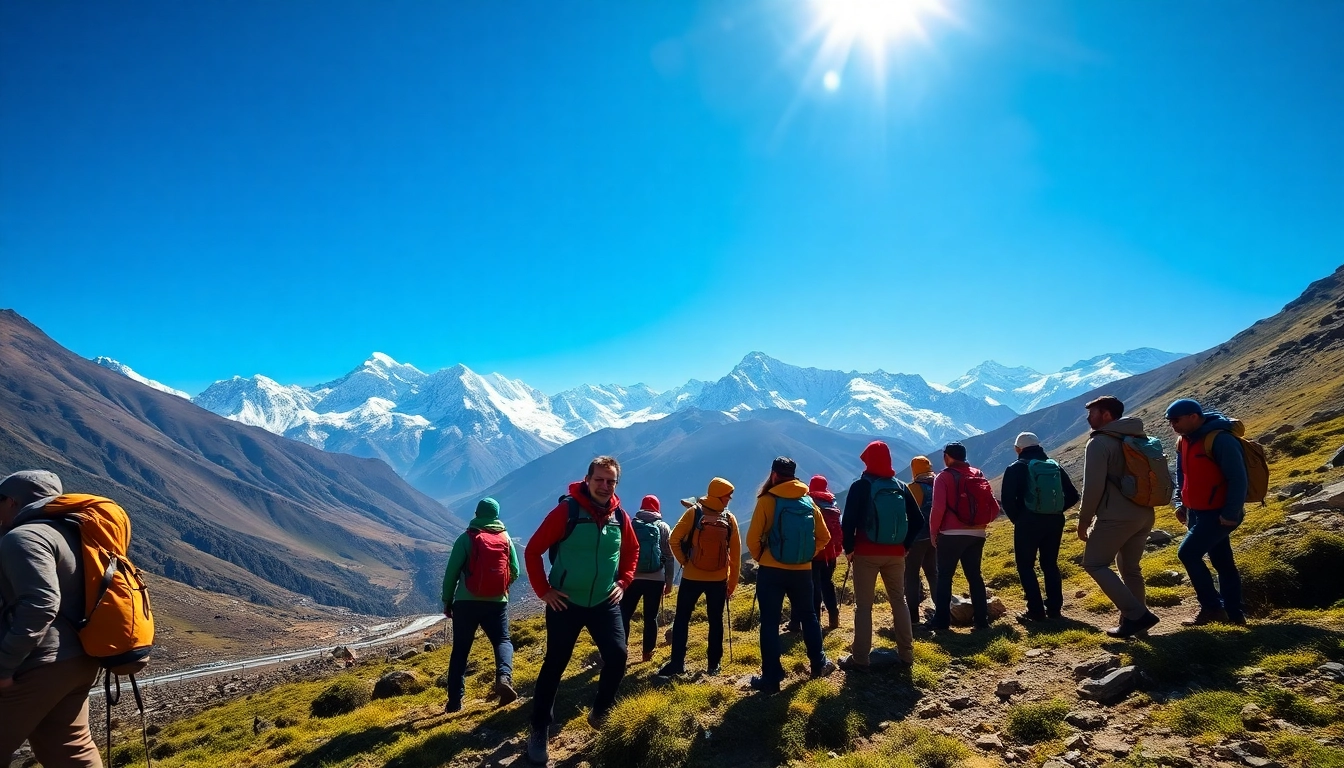Introduction to Manaslu Circuit Trek
The Manaslu Circuit Trek is one of the most captivating trekking routes in Nepal, offering a unique blend of stunning scenery, rich culture, and exhilarating adventure. Nestled in the Manaslu region of Nepal, this trek is often overshadowed by the more popular Annapurna and Everest circuits, making it a perfect destination for those seeking a less crowded experience. With its dramatic landscapes, from lush green hills to rugged mountains, the Manaslu Circuit is a feast for the eyes and a journey that promises unforgettable experiences.
Overview of the Trek
Starting from the village of Soti Khola, the Manaslu Circuit Trek typically spans around 177 kilometers and can take anywhere from 10 to 14 days to complete, depending on your pacing and itinerary. The trek ascends through various terrains, from subtropical valleys to alpine meadows, eventually leading to the high point at Larkya La Pass (5,160 meters), which provides breathtaking panoramas of the majestic Manaslu mountain— the eighth-highest in the world.
The journey encompasses a range of landscapes, allowing trekkers to experience the diverse ecosystems of Nepal. From the terraced rice fields and ancient forests to windswept high-altitude valleys, every step offers enchanting views. The circuit is less traversed than others, providing the opportunity for solitude and quiet contemplation amid nature’s splendor.
Geographical Significance
Geographically, the Manaslu Circuit is strategically located between the Annapurna and Tibet, making it a pivotal course for trekking in the Himalayas. The trek offers an opportunity to traverse diverse geographical zones, ranging from sub-tropical elevations to the cold, arid environments of the high Himalayas. Along the way, trekkers will encounter numerous rivers and boulevards, the most notable being the Budhi Gandaki River, which the trail follows for a considerable distance.
The area is also significant in terms of biodiversity. It features numerous microclimates which are home to a variety of flora and fauna, some of which are endemic to the region. Trekkers might encounter unique wildlife species such as the elusive snow leopard, red panda, and various high-altitude bird species.
Historical Context and Cultural Richness
The Manaslu region is steeped in cultural history, with its roots deeply embedded in the ancestral stories of the Gurung and Tibetan communities. The trek allows visitors to explore ancient villages such as Samagaon, where traditional lifestyles flourish, offering insights into the unique customs and traditions of the local people.
The presence of traditional Buddhist monasteries, such as the famous Pungyen Monastery, adds a spiritual dimension to the journey. These cultural landmarks serve as a reminder of the area’s religious significance, showcasing well-preserved artifacts and Tibetan Buddhism practices. The blend of nature and culture on the Manaslu Circuit meticulously crafts a trek that is both serene and enlightening.
Planning Your Manaslu Circuit Trek
Planning is crucial to ensure a safe and enjoyable experience on the Manaslu Circuit Trek. From choosing the right season to packing appropriately and understanding permit requirements, each element plays an essential role in your trekking adventure.
Best Seasons for Trekking
The ideal time for trekking the Manaslu Circuit is during the pre-monsoon (March to May) and post-monsoon (September to November) seasons. During these months, the weather is stable, and visibility is generally high, offering trekkers the best chance to witness the breathtaking views that the region has to offer.
In the spring, the trail blooms with wildflowers, and the temperatures are moderately warm, while the autumn season provides clearer skies and stunning yellow hues as foliage begins to change. However, trekking in the summer months can be challenging due to monsoon rains, and winter trekking is recommended only for the well-experienced, as the trails can be icy and temperatures plummet.
Essential Gear and Packing Tips
Choosing the right gear is imperative for a successful trek. Essential items include:
- Footwear: Invest in high-quality trekking boots that provide ankle support and are waterproof.
- Layered Clothing: Pack moisture-wicking base layers, insulating mid-layers, and a waterproof outer layer for varying weather conditions.
- Daypack: A comfortable, lightweight daypack is essential for carrying your daily essentials.
- Sleeping Gear: A sleeping bag suitable for low temperatures can be imperative when spending nights in teahouses.
- Hydration Systems: Water bottles or a hydration reservoir to stay hydrated while trekking.
Additionally, don’t forget personal items like a first-aid kit, sunscreen, sunglasses, and a power bank for electronic devices. Be mindful to pack light while ensuring you have all the essentials to enhance your trekking experience.
Permits Required for Manaslu Circuit Trek
Trekking the Manaslu Circuit requires specific permits due to its status as a restricted area. The following permits are essential:
- Manaslu Trekking Permit: This is mandatory for all trekkers and should be obtained from the Nepal Tourism Board.
- Restricted Area Permit: As the region borders Tibet, this permit is also necessary. It can be organized through trekking agencies.
- Annapurna Conservation Area Permit: While not directly a part of the Manaslu trek, portions of the trek fall within the Annapurna region, requiring this permit as well.
It’s advisable to acquire these permits in advance and to ensure they are checked at designated entry points along the trek.
Itineraries for Every Trekker
One of the appealing aspects of the Manaslu Circuit Trek is its flexibility in itineraries, accommodating trekkers of varying experience levels and fitness. Below are different itinerary options that highlight the beauty and challenge of the trek.
Six-Day Itinerary Overview
A six-day itinerary is ideal for those who may have limited time but still wish to experience the highlights of the trek. This option typically includes:
- Day 1: Drive from Kathmandu to Soti Khola and trek to Machha Khola.
- Day 2: Trek from Machha Khola to Jagat.
- Day 3: Journey from Jagat to Deng.
- Day 4: Trek to Namrung.
- Day 5: Ascend to Samagaon, enjoying the spectacular mountain views.
- Day 6: Trek back to Samdo, experiencing local culture along the way.
This shorter itinerary offers brief encounters with the majestic sights and sounds of the Manaslu region, albeit at a faster pace.
Longer Trek Options and Highlights
The classic itinerary for the Manaslu Circuit Trek spans about 14 days, providing a more immersive experience. Highlights include:
- Crossing Larkya La Pass: The high point of the trek at 5,160 meters features incredible views of Manaslu and Annapurna ranges.
- Exploring Lho: A chance to view ancient monasteries and enjoy the Tibetan culture.
- Stay at Lakeside Samagaon: Offers a bonding experience with the local people and exploration of the nearby Birendra Lake.
This itinerary allows trekkers to acclimatize to the altitude and fully appreciate the natural beauty and cultural richness of the trek.
Flexibility in Itineraries
Flexibility is key depending on individual preferences, physical fitness, and pacing. Many trekkers adjust their itineraries based on weather conditions or personal interests, such as opting for side trips to Tsum Valley or Gampi Hill for additional cultural exploration and scenic views. It’s essential to ensure that you are adequately prepared and informed about the challenges of longer treks.
Cultural Experiences Along the Manaslu Circuit Trek
The trek grants trekkers the unique opportunity to engage with local cultures and tradition. As you traverse various villages, each has its own stories to tell, epitomizing the rich heritage of the region.
Local Villages and Lifestyle
Villages such as Soti Khola, Machha Khola, and Samagaon are not merely stops along the way; they are vibrant communities where visitors can see traditional ways of life. Local customs, architecture, clothing, and lifestyle practices offer trekkers firsthand insight into the Gurung and Tibetan cultures.
Trekkers can interact with residents, partake in local handicrafts, or share in their farming and cookery practices, making each village visit a culturally enriching experience.
Traditional Festivals and Events
Depending on the time of your trek, you might encounter traditional festivals celebrated in these local communities. Events such as Losar (Tibetan New Year) are filled with colorful celebrations, showcasing dance, music, and local cuisine. Such interactions foster a profound appreciation for the culture and rituals that define the region.
Interaction with Local Guides and Sherpas
Engaging with local guides, often Sherpas, not only enriches the trekking experience but also builds connections that deepen your understanding of Himalayan culture. Their stories, knowledge of the land, and familial ties to the mountains provide an insightful context to the beauty surrounding the trek.
Additionally, these guides can offer tips on local etiquette, making trekking through the region an enjoyable and respectful experience.
Conclusion: The Rewarding Journey of the Manaslu Circuit Trek
The Manaslu Circuit Trek merges natural beauty and cultural immersion, offering not just a physical journey through the Himalayas but also a transformational experience for the soul. Each step taken along this circuit brings new insights, challenges, and a sense of accomplishment.
Personal Growth Through Adventure
Embarking on the Manaslu Circuit allows trekkers to confront both mental and physical challenges that foster personal growth. The physical exertion required, coupled with the stunning vistas and serene environment, cultivates resilience and a deeper understanding of one’s capabilities.
Capturing Memories: Photography Tips
For those wishing to document their journey, the Manaslu Circuit presents ample photography opportunities. It’s advisable to carry a lightweight DSLR or a mirrorless camera for stunning landscape shots and candid local interactions. Early mornings or late afternoons yield the best lighting for photography, capturing the golden hues cast over the majestic peaks.
Post-Trek Reflections and Sharing Experiences
After completing the trek, redefine your experience with reflections on your journey. Sharing stories, photographs, and encounters enhances the feel of community among fellow travelers. Consider presenting your adventure through blogs, galleries, or social media, thereby inspiring others to follow in your footsteps on this remarkable trek.



